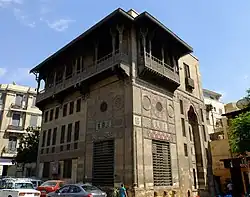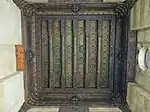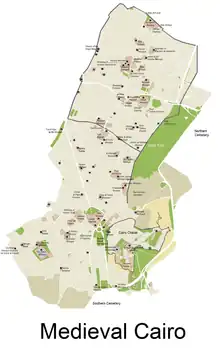| Sabil-Kuttab of Sultan Qaytbay | |
|---|---|
| Native name Arabic: سبيل وكتـّاب السلطان قايتباي | |
 View of the sabil-kuttab from Saliba street. | |
| Type | Sabil; kuttab |
| Coordinates | 30°01′51″N 31°15′17″E / 30.03083°N 31.25472°E |
| Founder | Sultan al-Ashraf Qaytbay |
| Built | 1479 CE (884 AH) |
| Restored | 1999 |
| Restored by | Supreme Council of Antiquities; Agencia Española de Cooperacion Internacional |
| Current use | tourist attraction (historic site); the Suzanne Mubarak Center for Islamic Civilization |
| Architectural style(s) | Mamluk, Islamic |
The Sabil-Kuttab of Sultan Qaytbay is a Mamluk-era charitable foundation and building in Cairo, Egypt. It was built in 1479 on the order of Sultan al-Ashraf Qaytbay and is located on Saliba Street in the historic districts of Cairo.[1][2][3]
The building is composed of a sabil (a water distribution kiosk) on the ground floor and a kuttab (primary school teaching the Qur'an) on the upper floors. Below the structure, underground, is a cistern from which water was drawn for the sabil. The structure was the first free-standing sabil-kuttab in Cairo; a type of building that would later become quite common during the Ottoman period.[4]
Gallery
 Entrance portal.
Entrance portal. Exterior polychrome marble and stone-carving decoration
Exterior polychrome marble and stone-carving decoration Interior of sabil chamber, with window through which attendant gave out water.
Interior of sabil chamber, with window through which attendant gave out water. Marble salsabil over which water flowed inside the attendant's chamber.
Marble salsabil over which water flowed inside the attendant's chamber. Painted wooden ceiling inside the sabil chamber.
Painted wooden ceiling inside the sabil chamber. The underground water cistern.
The underground water cistern.
See also
- Sabil of Qaytbay (at the Temple Mount in Jerusalem)
- Wikala and Sabil-Kuttab of Qaytbay (at al-Azhar)
- Funerary complex of Sultan Qaytbay (at the Northern Cemetery)
- Mamluk architecture
References
Wikimedia Commons has media related to Sabil-Kuttab of Qaytbay.
- ↑ Williams, Caroline (2018). Islamic Monuments in Cairo: The Practical Guide (7th ed.). Cairo: The American University in Cairo Press. p. 289.
- ↑ Torky, Tarek (2019). "Sabil (Water Dispensary) and Kuttab (Qur'anic School) of Sultan Qaytbay". Discover Islamic Art, Museum With No Frontiers. Retrieved November 6, 2019.
- ↑ Behrens-Abouseif, Doris. 2007. Cairo of the Mamluks: A History of Architecture and its Culture. Cairo: The American University in Cairo Press.
- ↑ Blair, Sheila S.; Bloom, Jonathan (1995). The Art and Architecture of Islam: 1250-1800. New Haven; London: Yale University Press. pp. 92.
This article is issued from Wikipedia. The text is licensed under Creative Commons - Attribution - Sharealike. Additional terms may apply for the media files.
